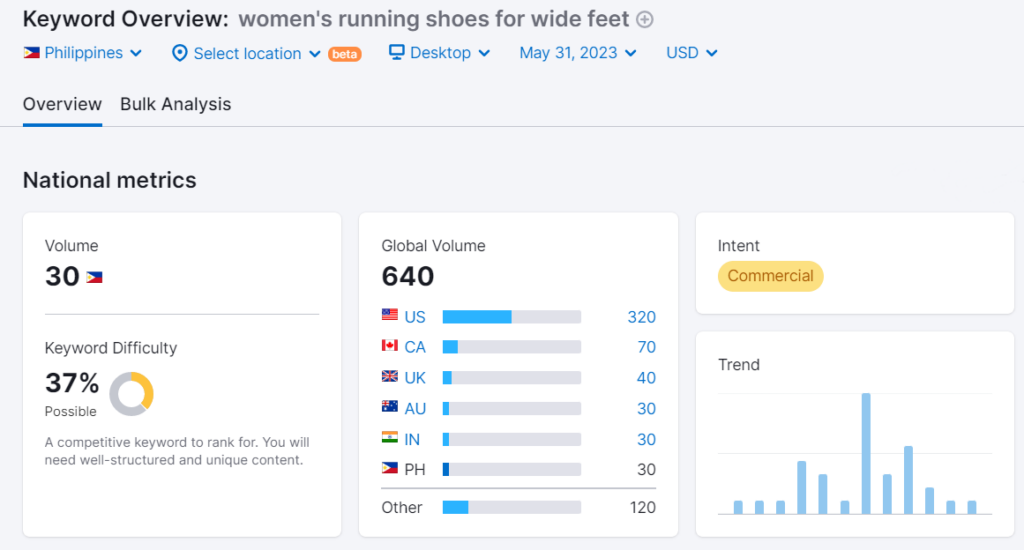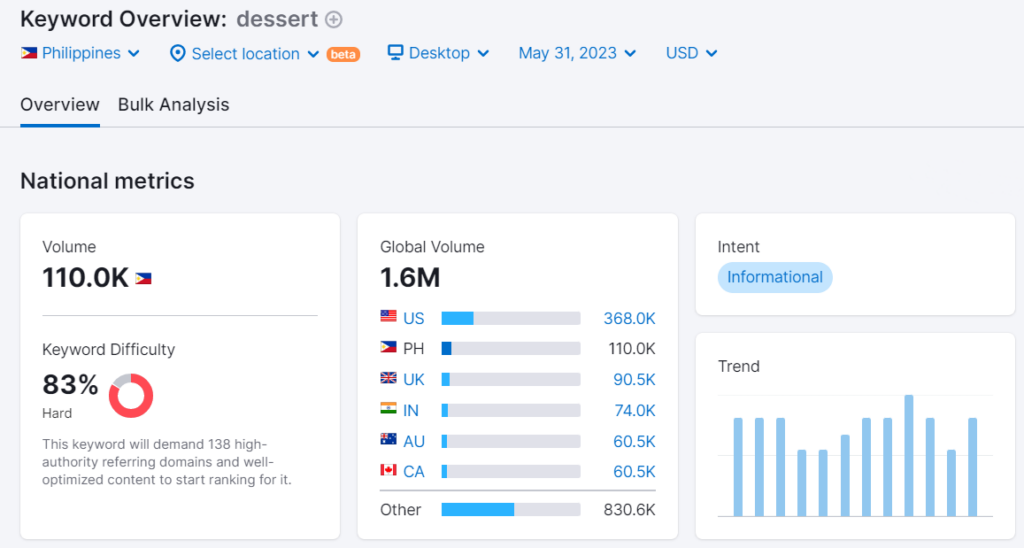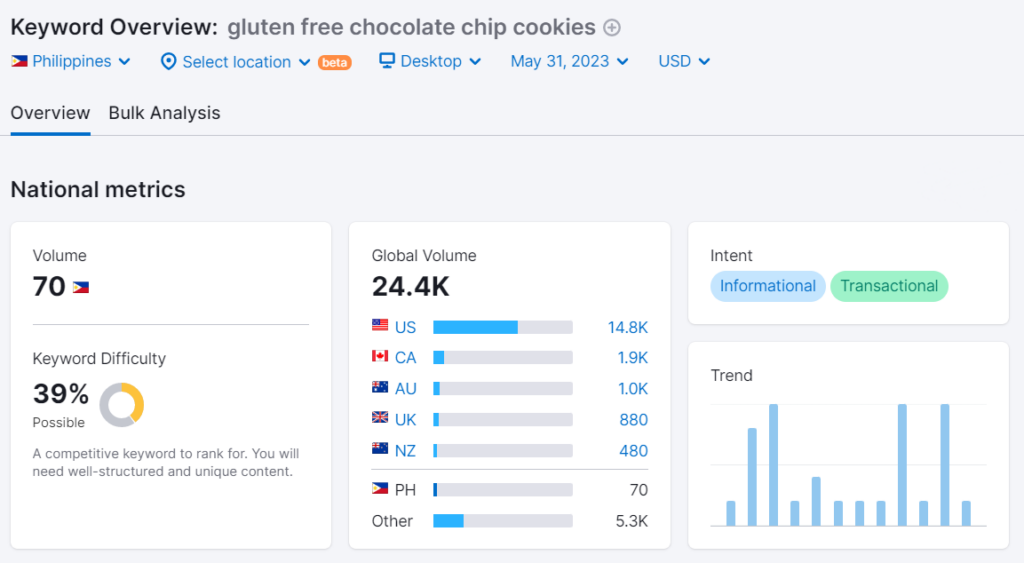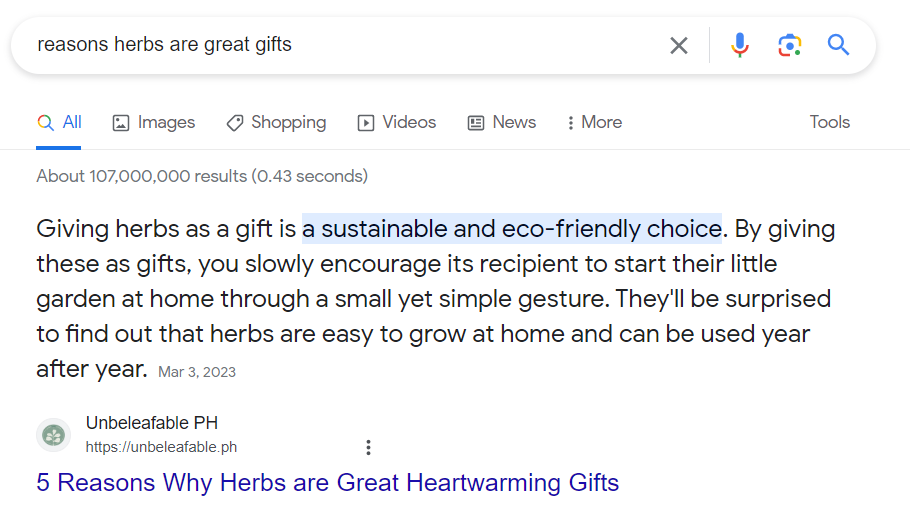SEO
Game-Changers for Your Website Traffic and Rankings

Keywords, as we all know, are the bread and butter of SEO. They are how potential customers find us online and are what we build entire strategies around.
But targeting the best keywords for your business is tough. Short tail keywords are attractive, but are often too competitive, too high volume for most to fight for—so what is the alternative?
Here’s where long-tail keywords come in. They provide an untapped opportunity to drive more relevant traffic to your website and connect with customers further along their purchase journey.
In this article, we’ll dive deep into the essence of long-tail keywords, examining their importance, advantages, and—most importantly—how to incorporate them effortlessly into your content strategy.
What is a Long-Tail Keyword?
Long-tail keywords in SEO are keyword phrases with more than three words that are extremely focused and specialized. These keywords are more targeted and reflect users’ exact search intentions than generic or broad-based keywords. They can also provide users with a more customized search experience.
The Power of Precision
When you are conducting keyword research, you can specifically target the wants and demands of your target market. You may draw readers who are more likely to convert by including these certain terms in your article.
For instance, if you own a running shoe business, it will be very difficult to rank at the top for the keyword “best running shoes,” much less gain much traffic from your efforts.

If, however, you decide to target the keyword “women’s running shoes for wide feet” instead, then you are more likely to draw highly interested customers who are looking for that exact product.

After all, when someone enters that very long, very specific keyword, they are demanding one thing: the kind of product that they just searched for on Google.
By positioning yourself as someone who can answer their demand, you grab their attention, answer their search question, and ultimately bring in users who are more likely to buy your product.
There is a value of precision that specific keywords provide. You may attract people who have a precise aim and are inclined to become clients by using such focused terms.
Less Competition=Less Cost
Though these keywords often have lower search volumes since they are more specific than short tail or broad keywords, there often are fewer opponents for this from other websites.
In that sense, you can also easily rank at the top of search engine results pages (SERPs) for these keywords, and attract more customers by focusing on untapped niches in a crowded online market.
So, this level of specificity of the keyword not only helps you reach a particular target audience but also distinguishes you from your competitors who may only optimize for broader keywords like “best running shoes.”
By catering to the needs and preferences of your audience, you also position your website as a trusted and reliable source for those looking for that particular product.
Providing people with exactly what they’re looking for will allow you to gain traffic almost effortlessly in a less competitive space, and drive conversions on your website.
What is an Example of a Long-Tail Keyword?
To further comprehend the idea of what a long-tail keyword is, let’s look at an example.
Consider a bakery that specializes in making desserts and sweets without gluten.

Instead of optimizing your website for a short tail keyword like “dessert,” an extended keyword example you might consider is “gluten free chocolate chip cookies.”

This phrase is extremely particular, addressing the dietary needs of a smaller audience looking for a particular type of dessert.
Aside from dietary needs, another way to find long-tail keywords is to look at the preferences of a potential customer. Things like flavor, color, or size can lead to a long-tail keyword. A customer might look for “mini chocolate frosted cupcakes,” which is another area you could target.
In short, almost every descriptor or variation of the products you offer is a long-tail keyword that you can potentially target.
Why Should You Integrate Long-Tail Keywords in Your Blog Posts?
Using long-tail keywords doesn’t just have to be on your website pages—it’s a great strategy for your monthly blogs, too.
Integrating these in your blog posts can have a significant impact on both your entire content plan and SEO efforts.
Focused Traffic
As I said earlier—these keywords reveal users’ intentions when they look for certain knowledge, goods, or services.
You can draw readers who are more interested in your content and offers by including long-tail keywords in your blog entries.
These users are also often further along in the purchasing process, which increases their likelihood of becoming customers.
You can direct targeted visitors to your blog and improve your chances of accomplishing your conversion goals by tailoring your content to their particular demands.
Enhanced Relevance
By focusing on writing for long-tail keywords, you can produce content that is incredibly relevant to the particular wants and needs of your target audience. You can satisfy their expectations by providing them with useful and informational blog entries by answering their specific questions.
This can also position your blog post as a reliable source of information in SERPs—usually in the form of a featured snippet or rich result for that search query.
Improved Search Rankings
High competition makes it difficult to rank highly in the search results for short, generalized keywords.

On the other hand, long keywords frequently have a lower search volume and face fewer competitors. By targeting these, you drive better results for much less effort and time spent. This is especially helpful if you work in a cutthroat industry.
You can quickly build your online presence, improve your exposure, and increase organic blog traffic by concentrating on long keyphrases.
When Should You Use Long-Tail Keywords in Your SEO?
To maximize their impact, long keyphrases must be used in the right situations within your SEO plan.
Here are some pointers on when you should use these keywords.
Niche Targeting
Long-tail keywords might help you more successfully reach your target market if your company works in a particular niche or caters to a specialized demographic. Although they could draw in a larger audience, generic keywords do not guarantee that they will be interested in your particular services.
You may boost your chances of bringing in highly relevant traffic by selecting keywords that represent the particular demands, preferences, or pain points of your audience.
For instance, if you sell eco-friendly yoga mats, you may reach yoga practitioners who are concerned about the environment and are looking for sustainable products by optimizing your SEO using long keywords like “natural rubber non-toxic yoga mats.”
Entering Competitive Industries
In highly competitive industries, it might be difficult to rank effectively for generic keywords in highly competitive sectors. Long-tail keywords provide you the chance to stand out and draw in a smaller but more intent audience.
You might find several long-tail keywords once you start your competitors’ analysis. When you do, you’ll see that the difficulty of targeting these is low, since they have lower search volumes and fewer people actively trying to rank for them.
This may be a golden opportunity for you—you can enter your industry through what is essentially a side door. Take gaming laptops, for example, where your website could enter by marketing your “thin and light budget gaming laptops.”
Focusing on a very specific part of the market can draw visitors who are actively looking for the exact goods, services, or information you provide. And, before you know it, you’ll have secured territory in a competitive arena.
Content Optimization
I said earlier that long-tail keywords are great for blog posts, and this plays into a larger strategy for content optimization.
Users frequently utilize longer and more precise keyword phrases while looking for information or solutions to their problems. You can give thorough and specific responses to these questions by including long keywords in your blog posts, articles, and FAQ sections.

Providing useful material not only enhances user experience but also helps address any content gaps your posts or pages may have. They can help you establish authority in your field and draw in people looking for in-depth information by including them in your content optimization plan.
Key Takeaway
Long-tail keywords are a potent optimization technique that increases conversion rates and drives focused visitors. You attract interested visitors who are more inclined to take action by concentrating on precise, pertinent keywords. These keywords provide you with a huge competitive advantage simply because of how targeted and exact they are.
Maximize your SEO potential now with long-tail keywords. Take charge of your website’s visibility, attract highly engaged visitors, and drive conversions like never before.
SEO
How To Write ChatGPT Prompts To Get The Best Results

ChatGPT is a game changer in the field of SEO. This powerful language model can generate human-like content, making it an invaluable tool for SEO professionals.
However, the prompts you provide largely determine the quality of the output.
To unlock the full potential of ChatGPT and create content that resonates with your audience and search engines, writing effective prompts is crucial.
In this comprehensive guide, we’ll explore the art of writing prompts for ChatGPT, covering everything from basic techniques to advanced strategies for layering prompts and generating high-quality, SEO-friendly content.
Writing Prompts For ChatGPT
What Is A ChatGPT Prompt?
A ChatGPT prompt is an instruction or discussion topic a user provides for the ChatGPT AI model to respond to.
The prompt can be a question, statement, or any other stimulus to spark creativity, reflection, or engagement.
Users can use the prompt to generate ideas, share their thoughts, or start a conversation.
ChatGPT prompts are designed to be open-ended and can be customized based on the user’s preferences and interests.
How To Write Prompts For ChatGPT
Start by giving ChatGPT a writing prompt, such as, “Write a short story about a person who discovers they have a superpower.”
ChatGPT will then generate a response based on your prompt. Depending on the prompt’s complexity and the level of detail you requested, the answer may be a few sentences or several paragraphs long.
Use the ChatGPT-generated response as a starting point for your writing. You can take the ideas and concepts presented in the answer and expand upon them, adding your own unique spin to the story.
If you want to generate additional ideas, try asking ChatGPT follow-up questions related to your original prompt.
For example, you could ask, “What challenges might the person face in exploring their newfound superpower?” Or, “How might the person’s relationships with others be affected by their superpower?”
Remember that ChatGPT’s answers are generated by artificial intelligence and may not always be perfect or exactly what you want.
However, they can still be a great source of inspiration and help you start writing.
Must-Have GPTs Assistant
I recommend installing the WebBrowser Assistant created by the OpenAI Team. This tool allows you to add relevant Bing results to your ChatGPT prompts.
This assistant adds the first web results to your ChatGPT prompts for more accurate and up-to-date conversations.
It is very easy to install in only two clicks. (Click on Start Chat.)
For example, if I ask, “Who is Vincent Terrasi?,” ChatGPT has no answer.
With WebBrower Assistant, the assistant creates a new prompt with the first Bing results, and now ChatGPT knows who Vincent Terrasi is.
 Screenshot from ChatGPT, March 2023
Screenshot from ChatGPT, March 2023You can test other GPT assistants available in the GPTs search engine if you want to use Google results.
Master Reverse Prompt Engineering
ChatGPT can be an excellent tool for reverse engineering prompts because it generates natural and engaging responses to any given input.
By analyzing the prompts generated by ChatGPT, it is possible to gain insight into the model’s underlying thought processes and decision-making strategies.
One key benefit of using ChatGPT to reverse engineer prompts is that the model is highly transparent in its decision-making.
This means that the reasoning and logic behind each response can be traced, making it easier to understand how the model arrives at its conclusions.
Once you’ve done this a few times for different types of content, you’ll gain insight into crafting more effective prompts.
Prepare Your ChatGPT For Generating Prompts
First, activate the reverse prompt engineering.
- Type the following prompt: “Enable Reverse Prompt Engineering? By Reverse Prompt Engineering I mean creating a prompt from a given text.”
 Screenshot from ChatGPT, March 2023
Screenshot from ChatGPT, March 2023ChatGPT is now ready to generate your prompt. You can test the product description in a new chatbot session and evaluate the generated prompt.
- Type: “Create a very technical reverse prompt engineering template for a product description about iPhone 11.”
 Screenshot from ChatGPT, March 2023
Screenshot from ChatGPT, March 2023The result is amazing. You can test with a full text that you want to reproduce. Here is an example of a prompt for selling a Kindle on Amazon.
- Type: “Reverse Prompt engineer the following {product), capture the writing style and the length of the text :
product =”
 Screenshot from ChatGPT, March 2023
Screenshot from ChatGPT, March 2023I tested it on an SEJ blog post. Enjoy the analysis – it is excellent.
- Type: “Reverse Prompt engineer the following {text}, capture the tone and writing style of the {text} to include in the prompt :
text = all text coming from https://www.searchenginejournal.com/google-bard-training-data/478941/”
 Screenshot from ChatGPT, March 2023
Screenshot from ChatGPT, March 2023But be careful not to use ChatGPT to generate your texts. It is just a personal assistant.
Go Deeper
Prompts and examples for SEO:
- Keyword research and content ideas prompt: “Provide a list of 20 long-tail keyword ideas related to ‘local SEO strategies’ along with brief content topic descriptions for each keyword.”
- Optimizing content for featured snippets prompt: “Write a 40-50 word paragraph optimized for the query ‘what is the featured snippet in Google search’ that could potentially earn the featured snippet.”
- Creating meta descriptions prompt: “Draft a compelling meta description for the following blog post title: ’10 Technical SEO Factors You Can’t Ignore in 2024′.”
Important Considerations:
- Always Fact-Check: While ChatGPT can be a helpful tool, it’s crucial to remember that it may generate inaccurate or fabricated information. Always verify any facts, statistics, or quotes generated by ChatGPT before incorporating them into your content.
- Maintain Control and Creativity: Use ChatGPT as a tool to assist your writing, not replace it. Don’t rely on it to do your thinking or create content from scratch. Your unique perspective and creativity are essential for producing high-quality, engaging content.
- Iteration is Key: Refine and revise the outputs generated by ChatGPT to ensure they align with your voice, style, and intended message.
Additional Prompts for Rewording and SEO:
– Rewrite this sentence to be more concise and impactful.
– Suggest alternative phrasing for this section to improve clarity.
– Identify opportunities to incorporate relevant internal and external links.
– Analyze the keyword density and suggest improvements for better SEO.
Remember, while ChatGPT can be a valuable tool, it’s essential to use it responsibly and maintain control over your content creation process.
Experiment And Refine Your Prompting Techniques
Writing effective prompts for ChatGPT is an essential skill for any SEO professional who wants to harness the power of AI-generated content.
Hopefully, the insights and examples shared in this article can inspire you and help guide you to crafting stronger prompts that yield high-quality content.
Remember to experiment with layering prompts, iterating on the output, and continually refining your prompting techniques.
This will help you stay ahead of the curve in the ever-changing world of SEO.
More resources:
Featured Image: Tapati Rinchumrus/Shutterstock
SEO
Measuring Content Impact Across The Customer Journey

Understanding the impact of your content at every touchpoint of the customer journey is essential – but that’s easier said than done. From attracting potential leads to nurturing them into loyal customers, there are many touchpoints to look into.
So how do you identify and take advantage of these opportunities for growth?
Watch this on-demand webinar and learn a comprehensive approach for measuring the value of your content initiatives, so you can optimize resource allocation for maximum impact.
You’ll learn:
- Fresh methods for measuring your content’s impact.
- Fascinating insights using first-touch attribution, and how it differs from the usual last-touch perspective.
- Ways to persuade decision-makers to invest in more content by showcasing its value convincingly.
With Bill Franklin and Oliver Tani of DAC Group, we unravel the nuances of attribution modeling, emphasizing the significance of layering first-touch and last-touch attribution within your measurement strategy.
Check out these insights to help you craft compelling content tailored to each stage, using an approach rooted in first-hand experience to ensure your content resonates.
Whether you’re a seasoned marketer or new to content measurement, this webinar promises valuable insights and actionable tactics to elevate your SEO game and optimize your content initiatives for success.
View the slides below or check out the full webinar for all the details.
SEO
How to Find and Use Competitor Keywords

Competitor keywords are the keywords your rivals rank for in Google’s search results. They may rank organically or pay for Google Ads to rank in the paid results.
Knowing your competitors’ keywords is the easiest form of keyword research. If your competitors rank for or target particular keywords, it might be worth it for you to target them, too.
There is no way to see your competitors’ keywords without a tool like Ahrefs, which has a database of keywords and the sites that rank for them. As far as we know, Ahrefs has the biggest database of these keywords.
How to find all the keywords your competitor ranks for
- Go to Ahrefs’ Site Explorer
- Enter your competitor’s domain
- Go to the Organic keywords report
The report is sorted by traffic to show you the keywords sending your competitor the most visits. For example, Mailchimp gets most of its organic traffic from the keyword “mailchimp.”


Since you’re unlikely to rank for your competitor’s brand, you might want to exclude branded keywords from the report. You can do this by adding a Keyword > Doesn’t contain filter. In this example, we’ll filter out keywords containing “mailchimp” or any potential misspellings:


If you’re a new brand competing with one that’s established, you might also want to look for popular low-difficulty keywords. You can do this by setting the Volume filter to a minimum of 500 and the KD filter to a maximum of 10.


How to find keywords your competitor ranks for, but you don’t
- Go to Competitive Analysis
- Enter your domain in the This target doesn’t rank for section
- Enter your competitor’s domain in the But these competitors do section


Hit “Show keyword opportunities,” and you’ll see all the keywords your competitor ranks for, but you don’t.


You can also add a Volume and KD filter to find popular, low-difficulty keywords in this report.


How to find keywords multiple competitors rank for, but you don’t
- Go to Competitive Analysis
- Enter your domain in the This target doesn’t rank for section
- Enter the domains of multiple competitors in the But these competitors do section


You’ll see all the keywords that at least one of these competitors ranks for, but you don’t.


You can also narrow the list down to keywords that all competitors rank for. Click on the Competitors’ positions filter and choose All 3 competitors:


- Go to Ahrefs’ Site Explorer
- Enter your competitor’s domain
- Go to the Paid keywords report


This report shows you the keywords your competitors are targeting via Google Ads.
Since your competitor is paying for traffic from these keywords, it may indicate that they’re profitable for them—and could be for you, too.
You know what keywords your competitors are ranking for or bidding on. But what do you do with them? There are basically three options.
1. Create pages to target these keywords
You can only rank for keywords if you have content about them. So, the most straightforward thing you can do for competitors’ keywords you want to rank for is to create pages to target them.
However, before you do this, it’s worth clustering your competitor’s keywords by Parent Topic. This will group keywords that mean the same or similar things so you can target them all with one page.
Here’s how to do that:
- Export your competitor’s keywords, either from the Organic Keywords or Content Gap report
- Paste them into Keywords Explorer
- Click the “Clusters by Parent Topic” tab


For example, MailChimp ranks for keywords like “what is digital marketing” and “digital marketing definition.” These and many others get clustered under the Parent Topic of “digital marketing” because people searching for them are all looking for the same thing: a definition of digital marketing. You only need to create one page to potentially rank for all these keywords.


2. Optimize existing content by filling subtopics
You don’t always need to create new content to rank for competitors’ keywords. Sometimes, you can optimize the content you already have to rank for them.
How do you know which keywords you can do this for? Try this:
- Export your competitor’s keywords
- Paste them into Keywords Explorer
- Click the “Clusters by Parent Topic” tab
- Look for Parent Topics you already have content about
For example, if we analyze our competitor, we can see that seven keywords they rank for fall under the Parent Topic of “press release template.”


If we search our site, we see that we already have a page about this topic.


If we click the caret and check the keywords in the cluster, we see keywords like “press release example” and “press release format.”


To rank for the keywords in the cluster, we can probably optimize the page we already have by adding sections about the subtopics of “press release examples” and “press release format.”
3. Target these keywords with Google Ads
Paid keywords are the simplest—look through the report and see if there are any relevant keywords you might want to target, too.
For example, Mailchimp is bidding for the keyword “how to create a newsletter.”


If you’re ConvertKit, you may also want to target this keyword since it’s relevant.
If you decide to target the same keyword via Google Ads, you can hover over the magnifying glass to see the ads your competitor is using.


You can also see the landing page your competitor directs ad traffic to under the URL column.


Learn more
Check out more tutorials on how to do competitor keyword analysis:
-

 PPC5 days ago
PPC5 days ago19 Best SEO Tools in 2024 (For Every Use Case)
-
SEARCHENGINES7 days ago
Daily Search Forum Recap: April 17, 2024
-

 SEO7 days ago
SEO7 days agoAn In-Depth Guide And Best Practices For Mobile SEO
-
SEARCHENGINES6 days ago
Daily Search Forum Recap: April 18, 2024
-
SEARCHENGINES5 days ago
Daily Search Forum Recap: April 19, 2024
-

 MARKETING6 days ago
MARKETING6 days agoEcommerce evolution: Blurring the lines between B2B and B2C
-

 SEO6 days ago
SEO6 days ago2024 WordPress Vulnerability Report Shows Errors Sites Keep Making
-

 WORDPRESS5 days ago
WORDPRESS5 days agoHow to Make $5000 of Passive Income Every Month in WordPress














